How to Create a Multilingual eCommerce Website in WordPress
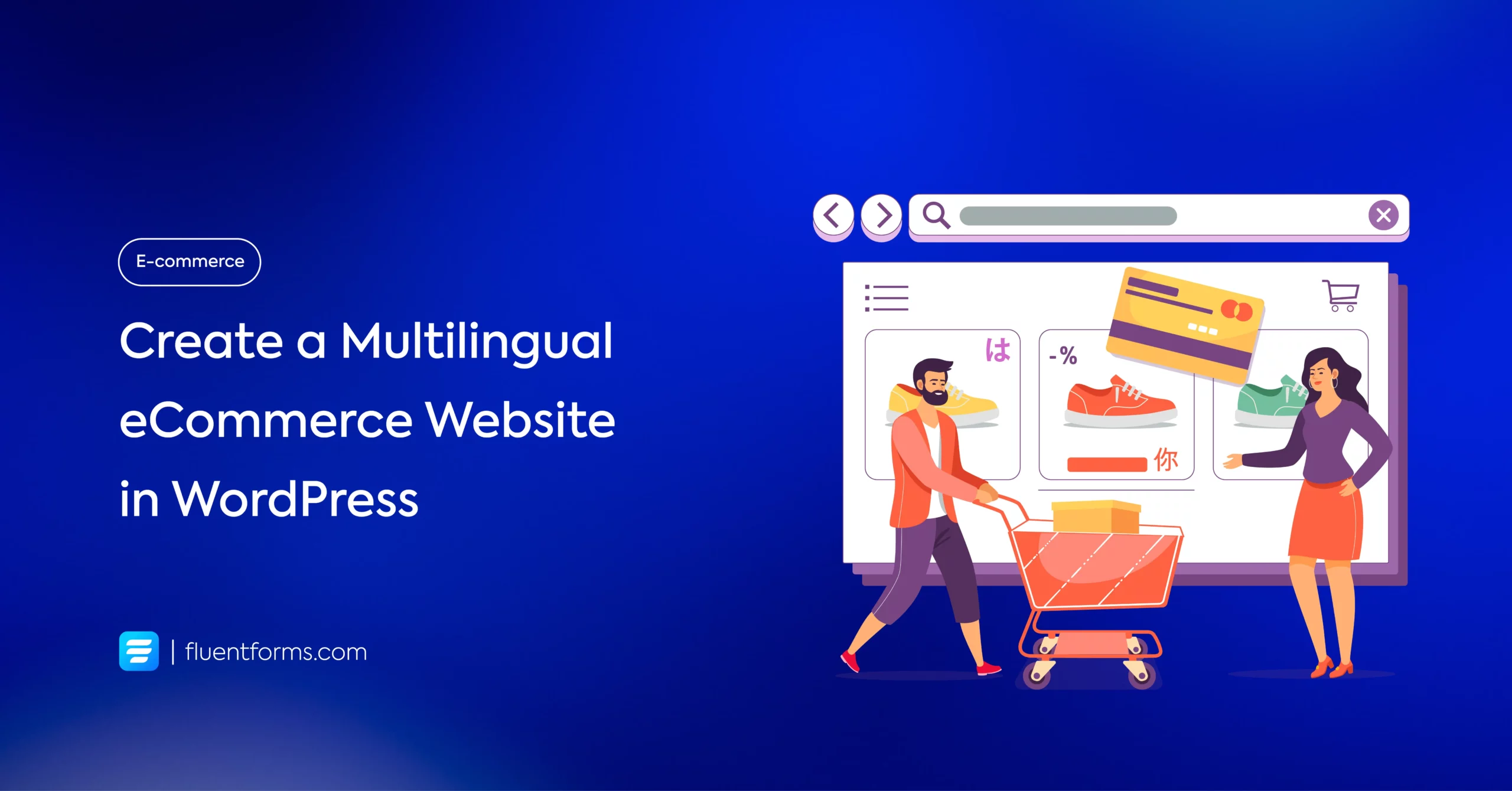
Connection is the heart of a business. A strong connection between you and your customers ensures the growth of your business. And it’s language that does the job.
When you plan to make your eCommerce store global, language becomes a barrier. Different cultures, languages, and regional habits decide the future of your global business.
In that case, your website needs a design that covers different languages as well as gives them a seamless user experience. To achieve all these, you need a multilingual website.
In this comprehensive guide, we’re diving headfirst into the step-by-step journey of creating a multilingual eCommerce right within WordPress.
What is a multilingual website?
Simply put, a multilingual website is a site that offers different languages. You can choose your preferred ones and navigate accordingly.
It allows users from different linguistic backgrounds to access the website and fulfill their queries. An international website and a multilingual website aren’t the same. International websites use only English whereas multilingual sites offer multiple languages.
Multilingual websites ensure a seamless and personalized user experience. Now, let’s find out the benefits of multilingual websites for eCommerce.
Benefits of a multilingual website for eCommerce
When you establish a multilingual website for your eCommerce store, it is an upgrade. Because it lets you uncover the areas where you couldn’t reach before.
A multilingual website has multidimensional benefits. They are:
Elevating customer experience
Customer experience is one of the core factors that helps your business grow. When you have a multilingual eCommerce website, you provide your users with a personalized and user-friendly experience.
This experience makes them stay on your website a bit longer resulting in a lower bounce rate. This also shows that you are committed to serving a diversified audience.
Reaching a wider range of customers
With a multilingual website, you open the door for customers who could never reach you before. About 58.8% of web content is in English; this should make you feel you have covered a lot. But there’s a huge possibility that you can have the most potential conversions from the rest 41%.
So, multilingual websites let you touch your untapped audience. This ensures that you don’t miss out on any opportunity to target your potential customers from different demographics.
Improving Search Engine Optimization (SEO)
Search Engine Optimization (SEO) is a key focus when you’re running an eCommerce website. When you expand your business globally, remember that your customers can search in their native language.
To make your eCommerce website SEO-friendly, you have to understand the search intent of different customers from different languages. Search intents can be different when they’re using their native language. That’s why a multilingual website is important.
Having your site totally translated – including metadata, and having unique URLs with language-specific subdomains are features of a multilingual website. These features make websites easily scannable for search engines. Thus the possibility of your website ranking higher increases.
Standing apart from the competition
If you have a multilingual website and your competitors don’t, then your chances are higher to reach your target. As said, having multiple language-choosing options lets your customers connect with you as they want.
When you have different languages to choose from, it also signifies that you value and respect the linguistic diversity of your users. This builds trust and loyalty among your international users.
Improving brand image
When you have a multilingual website, it indicates your business is global. It also implies the sophistication you possess and the effort you can give to your customers.
In your customer’s eyes, you become a symbol of quality and professionalism.
Understanding all the benefits of multilingual plugins, now we’re set to find out which are the best multilingual plugins available for you to choose from.
5 Best multilingual plugins in WordPress
There are a handful number of multilingual plugins in WordPress. They all have their unique features to offer. It’s up to you to decide, which one fits properly in your budget and purpose.
The multilingual plugins vary in the number of languages they are available in, word limitations, and also limitations on translating different parts of your website.
The one that has fewer limitations, comes with a price. So, before buying a multilingual plugin, check if it aligns with your expectations or not and spend accordingly.
Among the available multilingual plugins, we picked the best 5 of them. In no particular order, they are:
1. GTranslate
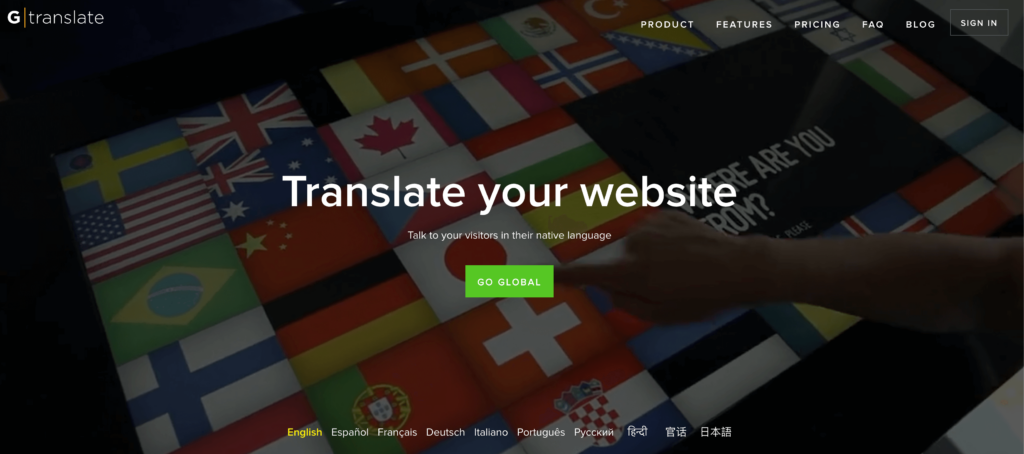
- A freemium multilingual that uses Google Translate API to translate WordPress sites automatically
- 100+ languages supported, unlimited words and page views available
- Two custom URL structures are offered, that help you manage the translated content
- Customizable language switcher widget makes language switching easy
- Paid plan starts at $9.99/month, billed monthly
2. Polylang Pro

- A freemium multilingual plugin, that lets you translate the posts, menus, categories, and even the WordPress widgets of your website
- Unlimited languages are offered, and translations are separable into different directories or subdomains based on language
- Language switcher widget available
- Lingotek integration helps you manage translation projects
- Compatible with WordPress SEO plugins
- The premium plan starts at €99
3. TranslatePress
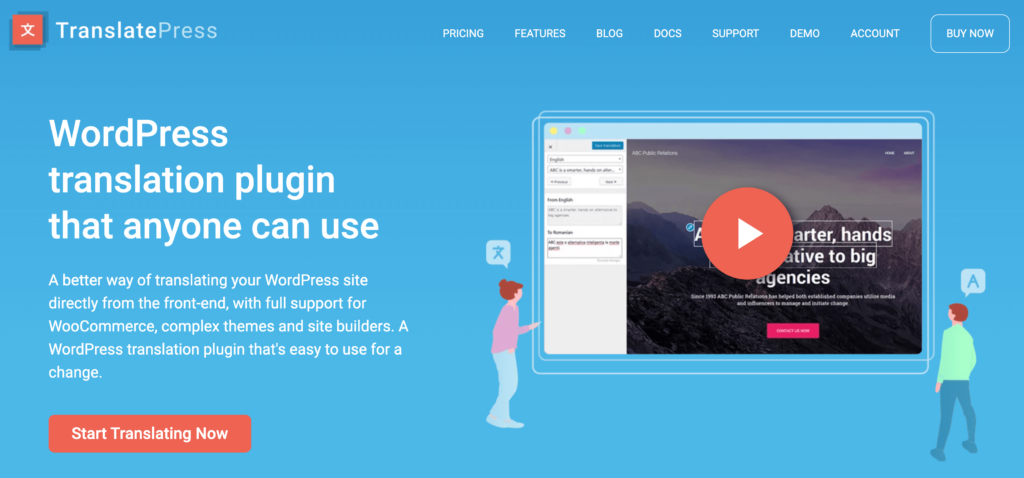
- A freemium WordPress multilingual plugin. It can translate content, media, custom post types, WordPress themes, plugins, and many more
- Supports both manual and automatic translation
- Lets your users translate directly on the front end. The live preview feature helps you go back and forth between languages easily when translating
- The premium version comes with €89/year for a single site
4. Weglot
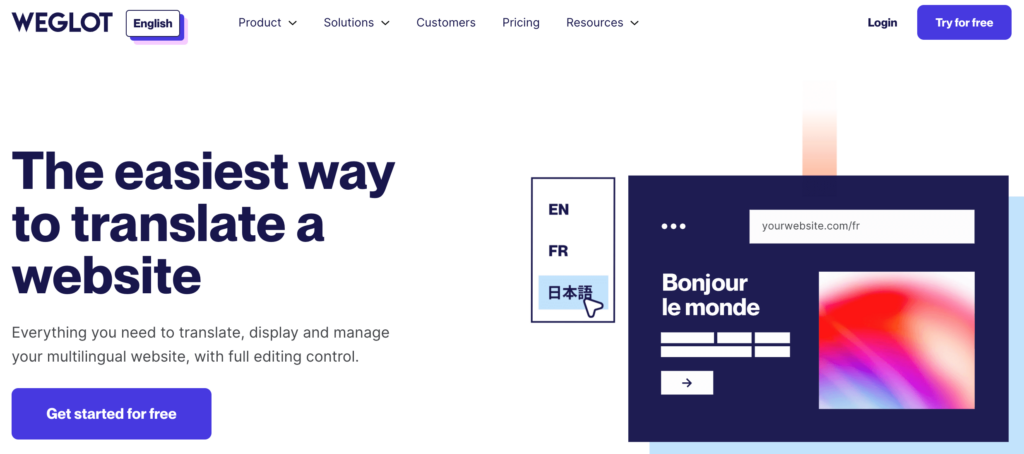
- Paid WordPress multilingual plugin, that supports both manual and automatic translations
- Integrated with the top-ranking automated translation providers, such as Google, DeepL, and Microsoft
- It’s user-friendly and offers two translation interfaces.
- Translation service can be commissioned directly from the dashboard if needed
- The premium plan has six pricing options, the lowest is €15/month for one translated language and up to 10,000 words
5. WPML
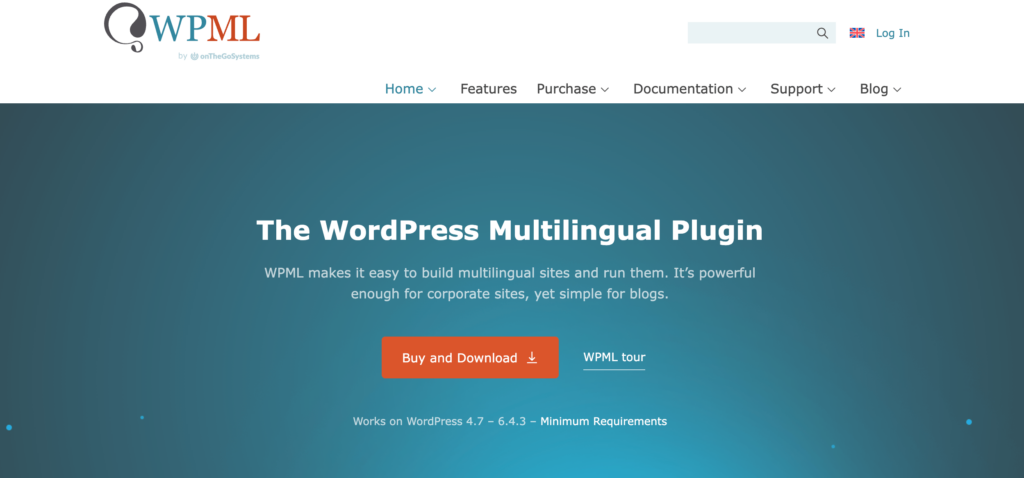
- It’s a premium plugin with many exciting functionalities. It allows you to translate a website, its theme, plugins, taxonomies, strings, custom fields, and many more fields
- It has a translation management system, that lets you assign translator roles to other users
- Provides you with three options to translate contents, and also three options regarding URL structures
- It comes with around 40 language options
- There are varieties of pricing options, but the most popular is Multilingual CMS bundle that costs €99/year
These are the top picks when talking about multilingual plugins for your WordPress website. Now let’s see how can you make a multilingual website using one of these plugins.
How to make a multilingual website with a plugin?
You can make your website multilingual with any of the plugins mentioned above. Most of them have common functionalities. Also, installing and configuring the plugins also have similarities.
We randomly picked one of the multilingual plugins mentioned above and going to show you how to use it on your website.
Let’s learn how to make your website multilingual with TranslatePress.
Creating a multilingual eCommerce website with TranslatePress
With TranslatePress you don’t have to create different versions of the articles for translations. You can translate simultaneously with only one version in different languages. Here’s how to use it:
Step 1: You need to install and activate the TranslatePress plugin on your WordPress dashboard first. Then you can hover your cursor on settings and you’ll see TranslatePress there. Click on it and let’s get started with the configurations.
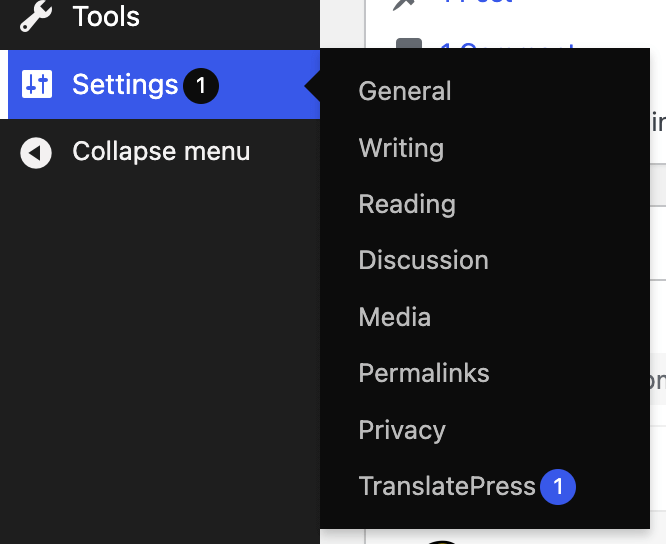
Step 2: In general settings, set your default language, and also add languages you need to translate to. Let other options remain untouched if you’re a beginner.
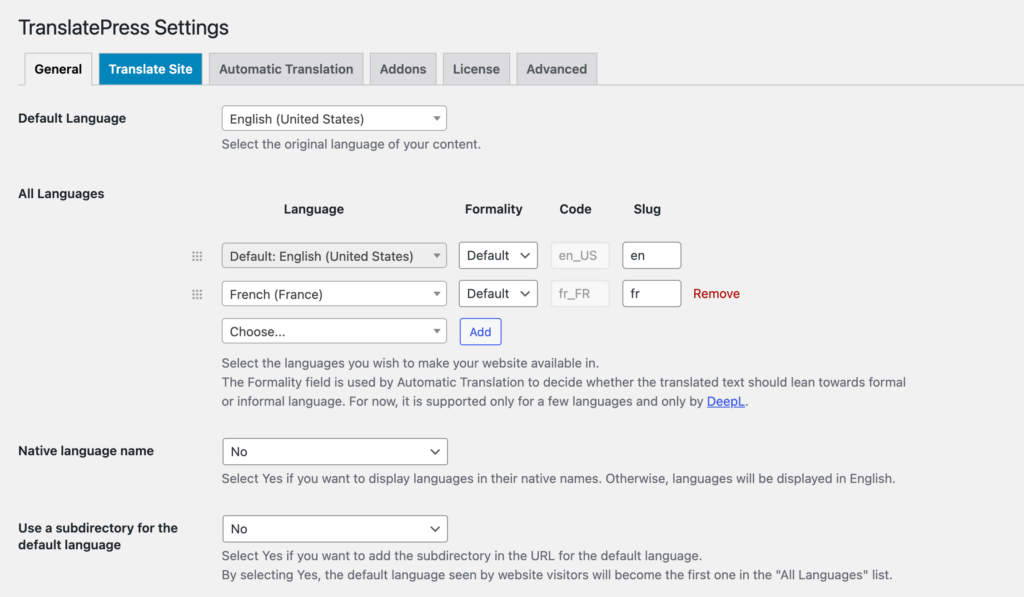
Step 3: Customize the visuals and position of your language switcher as you wish. Click on ‘Save Changes’ for all these settings to apply.
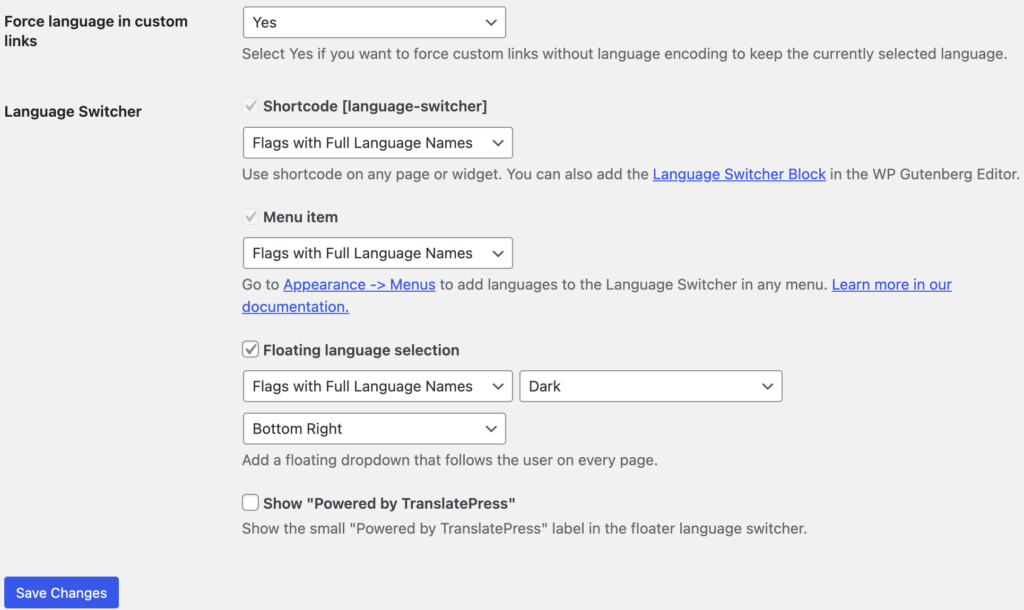
Now your website has become multilingual. But wait, until your contents are translated, how would it help you? Let’s translate your content now.
Step 4: Go to ‘Translate Site’ on your WordPress admin bar. A live translation editor will appear.
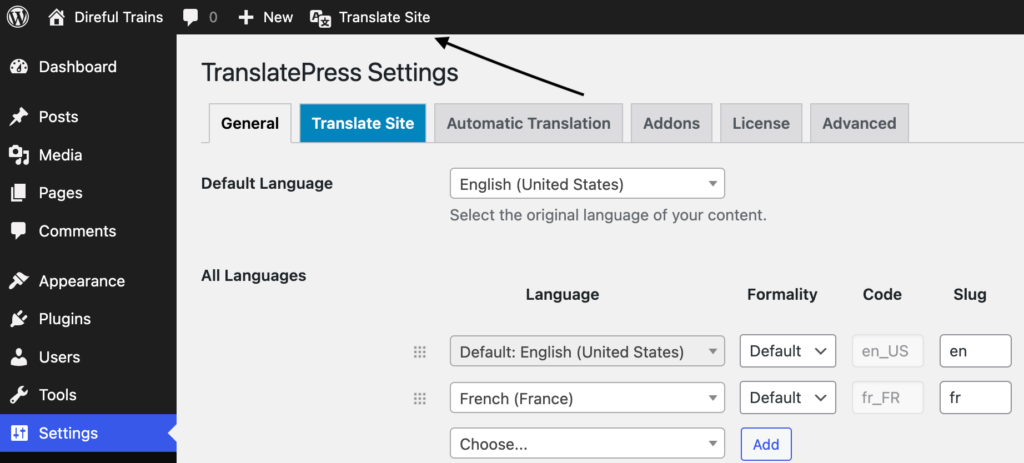
Step 5: From the live translator you can choose any content or any text string of your website, just choose which language you want to translate to and then provide the translation. Save your translation.
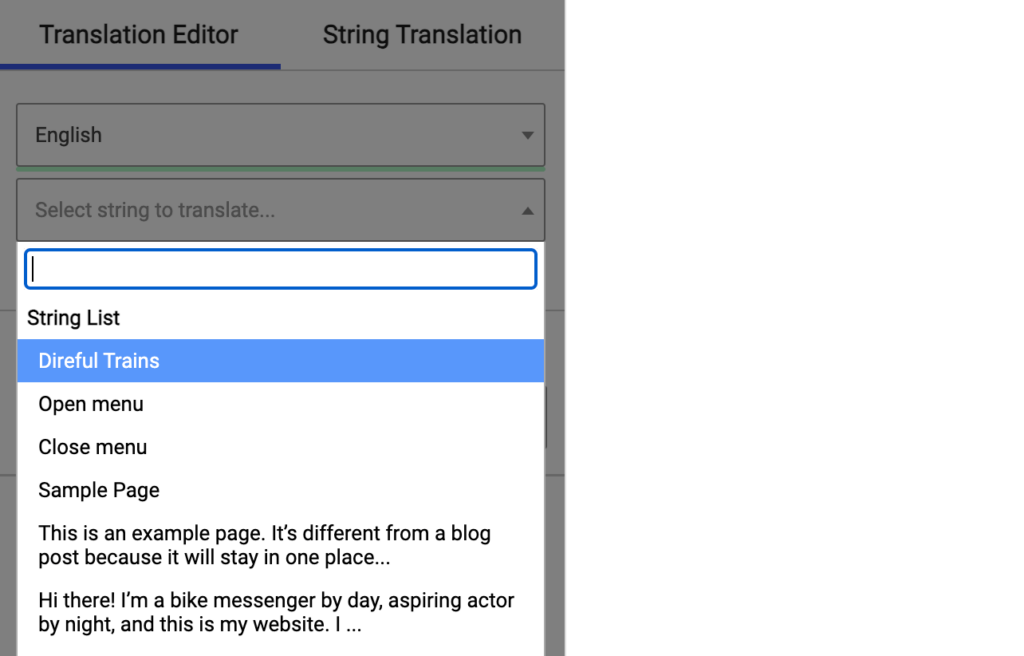
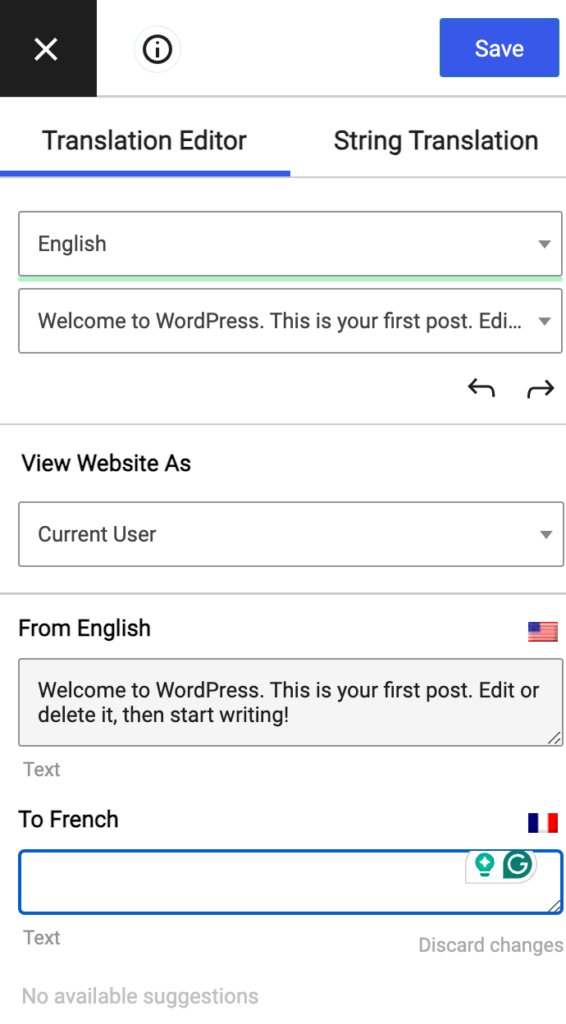
Step 6: Check your language switcher if it is correctly placed as you wanted. And if it looks good, then your multilingual website is ready to roll.
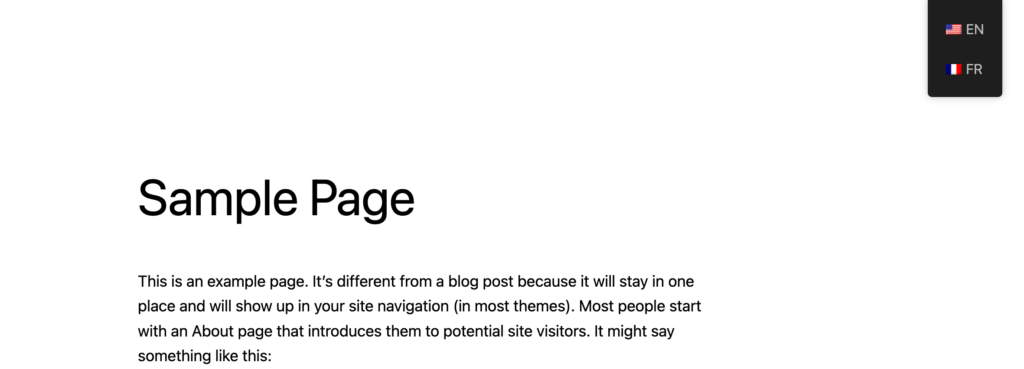
These are the simple steps you can follow to make a multilingual website. There are many more customizations possible but we tried to stick to the basics.
Making a multilingual website is also possible without a plugin. But which one should you choose? Plugin or No Plugin? Let’s find out.
Plugins vs No Plugins
You can also build your multilingual eCommerce website in WordPress without any plugins. To understand which way should you choose, here’s a table of comparison to help you understand.
| No plugins | Plugins |
| You don’t have to pay | You can set an unlimited amount of sites and languages |
| You can set unlimited amount of sites and languages | All plugins have limits regarding the amount of sites and languages. |
| WordPress Multisites is also free | You need to upgrade by paying for multiple sites |
| Setting up requires technical knowledge | Installing a plugin and setting it up doesn’t require any technical knowledge |
| You have to configure all sites by hand | Plugins can easily configure all sites |
| You have to link each individual content to all its language versions | You can provide translations for individual contents easily without linking manually |
| Dashboards of each new sites will be in that particular language | The dashboard remains the same language that you are comfortable with |
From the table, it’s clear that without a plugin there are some hassles you need to go through but it saves you money. But, with a plugin, you spend to have an effortless experience. Which way you should choose, depends on your budget as well as the amount of time and effort you want to invest.
Plugins or No Plugins? That’s up to you. For now, let’s move on to find out some inspiring websites for you to follow before you build yours.
5 Best multilingual website examples to inspire you
At this point, we’ve covered the reasons and also the steps for building a multilingual eCommerce website in WordPress.
But, just creating a multilingual website isn’t enough at all. You need to put your effort when localizing your eCommerce as you want to make super personalization.
When you go global, making customers happy, who belong to different parts of the globe is difficult. They have their own culture and emotions that differ from region to region. So, it’d be an uphill battle for you.
But, don’t worry. Here’s a roundup of the 5 best multilingual websites that can inspire you to create your unique multilingual website.
1. Jumia
Jumia can be an inspiring figure for your eCommerce website as it’s an eCommerce retailer. Its website’s homepage opens in the local language according to your location. Awesome isn’t it?
In most markets, Jumia lets customers see products in two languages, except for Senegal where it’s only in French, and Nigeria and Kenya where it’s only in English.
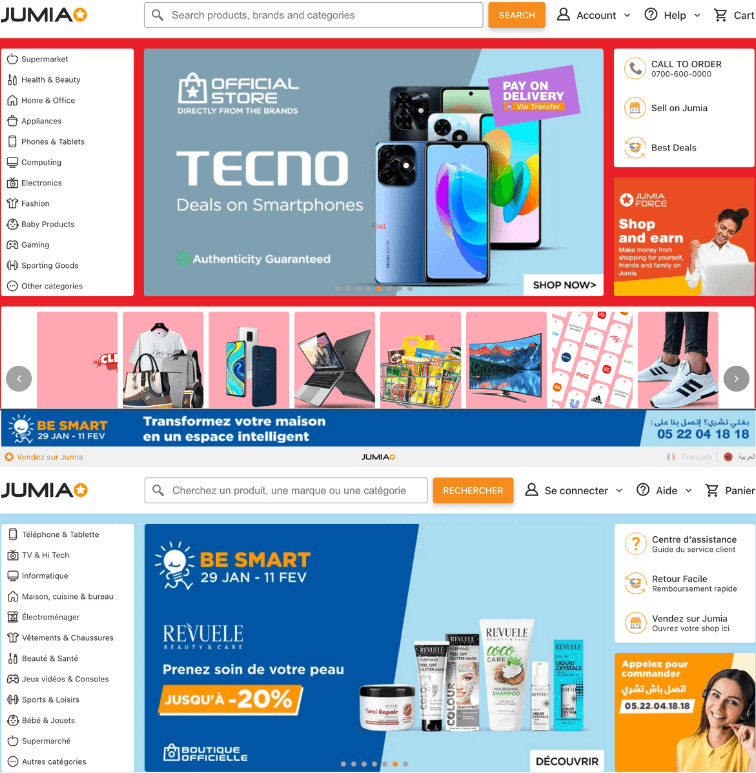
What makes Jumia’s website stand out?
- Ease of language change.
- Localization according to users. It uses local flavors for each country to make them feel connected.
- Country-based priority. Despite keeping the language French in Senegal and Tunisia, the order of categories is different
2. Netflix
Netflix’s homepage contains the same format in every country. But it offers a bilingual facility to its users. Thus the users can use either English or their local language.
So, if someone is accessing from Japan, they can view the site in English or Japanese.

What makes Netflix’s website stand out?
- Available in 40+ languages.
- Easy navigation even if you don’t know the language.
- Offers easy-to-follow guidelines for viewing its contents from different countries.
3. Wheat Straws
Wheat Straws is a Dutch company, and its website contains both Dutch and English for its clients.
The fact that it’s not only nature-friendly but also a user-friendly company, is proven by its website.
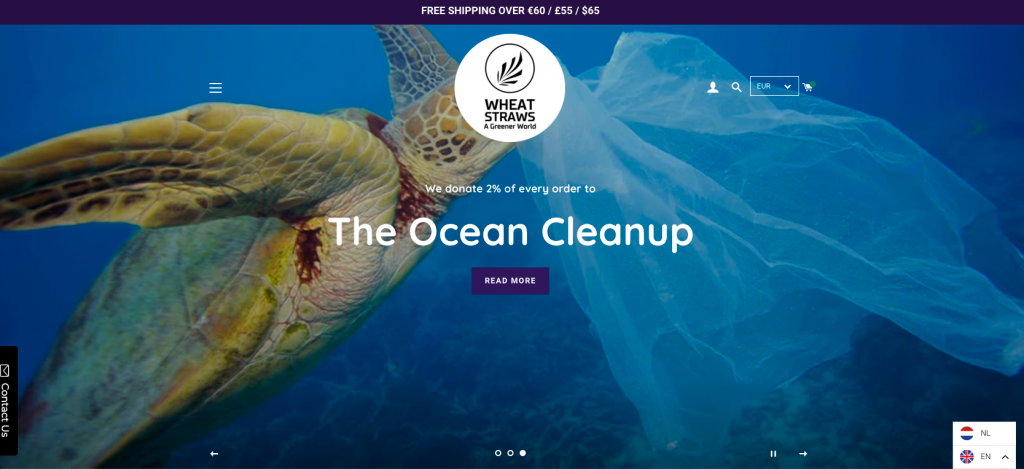
What makes Wheat Straws’ website stand out?
- Translated banners on the top of the website to ensure people speaking either of the two languages understand their deals.
- Fully translated checkout process.
- Fully translated FAQ section.
- Purchasing in three different currencies is also possible according to customer needs.
5. Ikea
Ikea is a ready-to-assemble furniture maker company. Its website supports about 26 languages.
It’s designed in a way, that it can connect to audiences from different regions in the way they want. Not only language but also the psychographics of different people have been catered to.
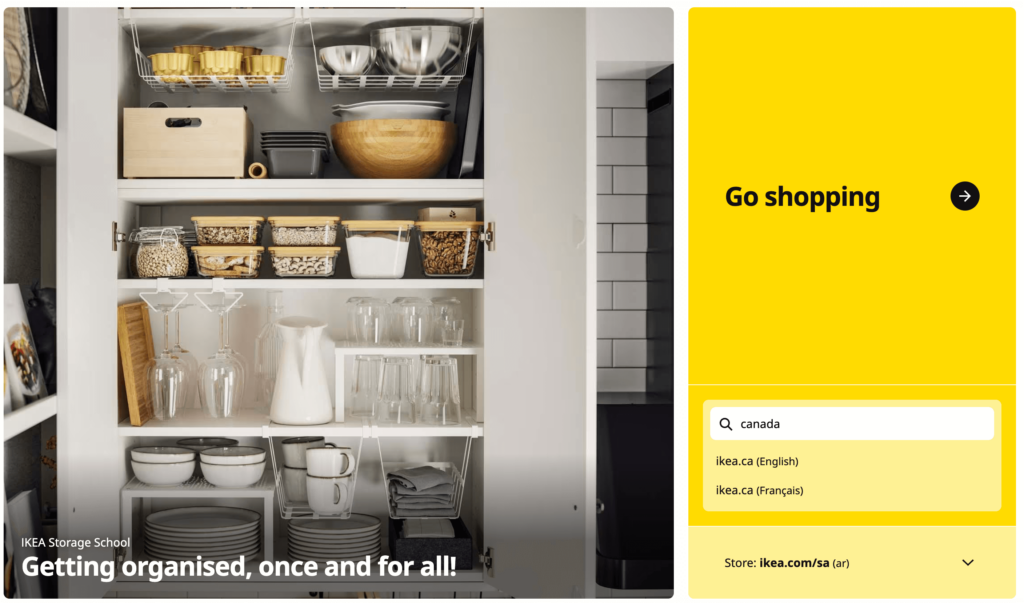
What makes Ikea’s website stand out?
- You can choose your country and language according to your preference
- Multiple languages are available even in the same country.
- On the same page of a country offers different tastes and descriptions.
- The warm and homey language is used.
These websites can be your inspiration when building your multilingual eCommerce website. Learning from them gives you a chance to find your catch to attract your customers. But don’t forget the best practices in the meantime.
5 Best practices for multilingual websites
Making a multilingual website doesn’t only mean just translating. The main goal is to connect with your customers. So, always check for the basics that shouldn’t be missed. Otherwise, it can backfire on your business.
Here are some of the best practices for your multilingual eCommerce website:
1. Consistency of the tone
Translating word by word isn’t appreciated. Always provide translations that match the emotion and tone of the original one.
However, the approach can differ from region to region. Try to provide the best-suited tone for your target people from different regions.
2. Language switcher’s position
As you have to provide a language switcher for your users, always put that in a prominent position.
If the positioning isn’t good, your leads might leave without even understanding that your website is multilingual. That’s why position your language switcher, where it’s visible.
3. Using the flags
Avoid using only the flags in your language switcher. Because things get confusing when you use only flags.
Firstly, there’s no clarification of the fact that which flag determines which language. Also, one country can have several languages. That’s why you should use flags with the name of the language itself.
4. Website design in different languages
Your website may look cool in one language but it’s not always happening for other languages. So, check your website’s design in different languages and see if it looks the same.
As the fonts and their styles differ from each other for different languages, they can make a difference in the look as well. Be aware of that.
Also, for right-to-left languages, you need to work on some adjustments to ensure the usability for your users.
5. Time and Date format
When you’re focusing on localization, you also need to look out for different formats of time and date.
People from different regions are used to different formats of time and dates. Some countries follow a month-day-year format whereas some follow a day-month-year format. Regarding the time, preferences for 24-hour over 12-hour format or vice-versa exist.
Failure to choose the right format can create a lot of confusion among your customers.
Conclusion
In this complete walkthrough for building your multilingual website, we’ve tried to focus on the basics that you need to cover. You can take inspiration from the best or even find your way to grab people’s attention with your website.
Whatever the tweaks you make to your multilingual website, don’t miss that the focus is on a deeper connection with your customers. The greater the connection your customers from different corners of the world feel, the more your business grows.
Your multilingual websites can do wonders if you utilize them to the fullest for global eCommerce. Good luck!
Let us know your thoughts in the comments below. Share it with your friends who are struggling with creating a multilingual website if you find it helpful.


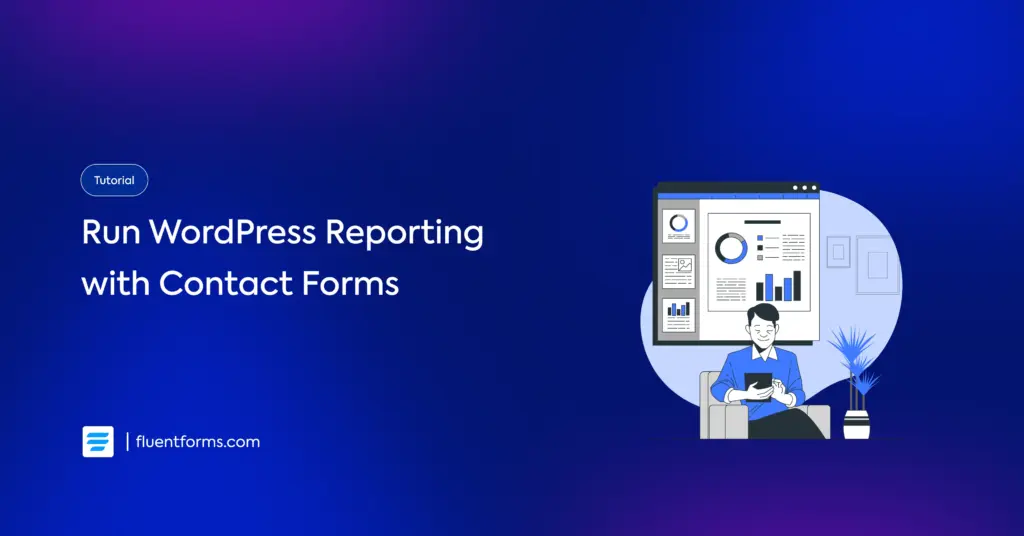




Leave a Reply